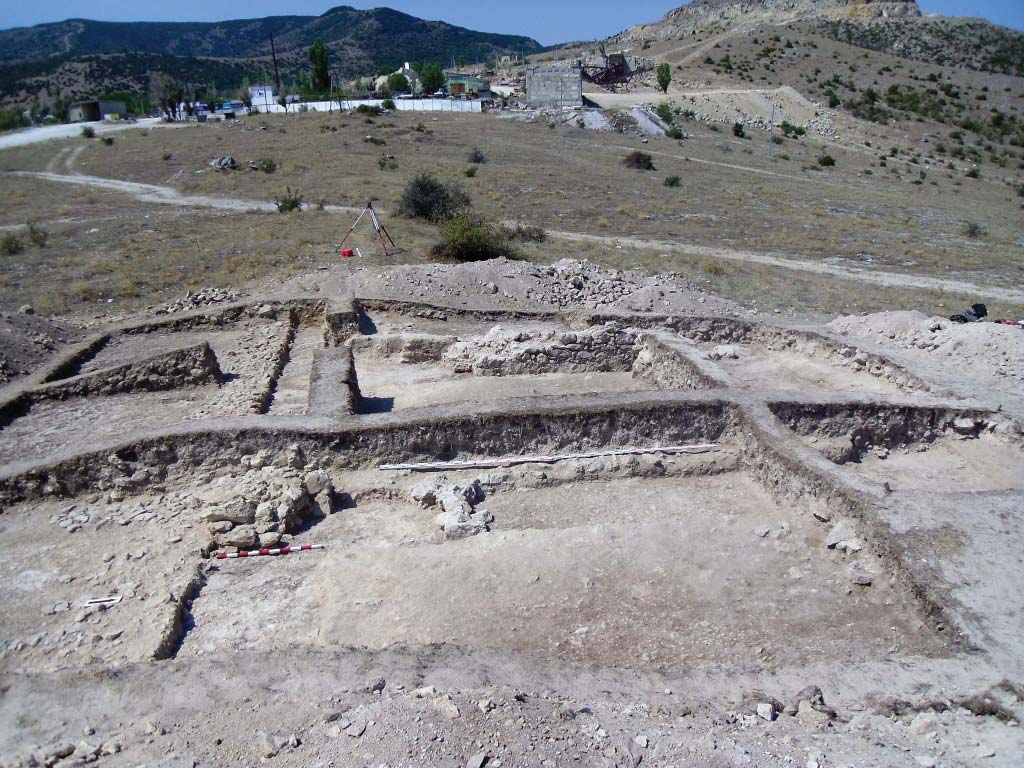DEFENSIVE STRUCTURES OF MEDIEVAL SOLKHAT (HISTORICAL AND ARCHAEOLOGICAL COMMENTARY)
DOI:
https://doi.org/10.24852/2587-6112.2020.6.316.336Keywords:
archaeology, Ulus of Jochi, Golden Horde, Crimea, Solkhat, Old Crimea, fortificationAbstract
In 2009-2012, the Old Crimean archaeological expedition of the State Hermitage, together with the expedition of the Crimean Engineering and Pedagogical University, carried out a study at the site of the fortifi cations of medieval Solkhat. Based on the analysis of written, cartographic and archaeological sources, it has been established that the formation of the defensive belt took place in two stages. First, in the 1360s, a defensive moat and rampart were erected around the city. Subsequently, in the 1380s, fortress walls were built. The remains of three fortress towers and sections of the defensive wall were excavated during the period of archaeological studies. The towers and fortress wall were dismantled in modern and recent history by the local population
for building materials and have only preserved fragmentarily at the level of the lower rows of masonry and in the form of wall foundation trenches. Near tower № 2, the opening of the fortress wall, and, probably, a secret gate protected by the tower were discovered. The published materials expand the current understanding of the fortifi cation of the Golden Horde center of Crimea.
References
Babayan, F. S., Korkhmazyan, E. M. 2000. Armianskie monastyri Surb Khach i sviatogo Stepanoca bliz goroda Staryi Krym (Surp Khach and Saint Stepanos Armenian monasteries near the city of Staryi Krym). Erevan (in Russian).
Skrzhinskaya, E. Ch. 1971. Barbaro i Kontarini o Rossii. K istorii italo-russkikh sviazei v XV v. (Notes on Russia by Barbaro and Contarini. The history of Italian-Russian Relations in 15th c.). Leningrad: “Nauka” Publ. (in Russian).
Grigor‘ev, A. P. 2003. In Vestnik Sankt-Peterburgskogo universiteta. Istoriya. Seria 2 (Vestnik of Saint Petersburg University. History. Series 2) 4(26). 201–213 (in Russian).
Dyubua de Monpere Frederik 2009. In Fadeeva, T. M. (transl.). Puteshestvie v Krym. (Voyage autour du Caucase, chez les tcherkesses et les Abkhases, en Georgie, en Armenie et En Crimee) 5–6. Simferopol: “Biznes-Inform” Publ. (in Russian).
Keppen, P. I. 1837. Spisok izvestneishm kurganam Rossii (List of the most renowned mounds of Russia). Saint Petersburg (in Russian).
Kramarovskii, M. G. 1996. In Ermitazhnye chteniia pamiati B. B. Piotrovskogo. (Hermitage Readings in Memory of B. Piotrovsky). Saint Petersburg: State Hermitage Museum, 38–41 (in Russian).
Kramarovskii, M. G. 2012. Chelovek srednevekovoi ulitsy. Zolotaia Orda. Vizantiia, Italiia (Man from medieval streets. Golden Horde, Byzantium, Italy). Saint Petersburg: “Evraziia” Publ. (in Russian).
Kramarovskii, M. G. 2014. In Alekseev, A. Yu., Butyagin, A. M. (eds.). Arkheologiia. Ekspeditsii v Ermitazhe (Expeditions. Archeology in the Hermitage). Saint Petersburg: “Slaviia” Publ., 138–153 (in Russian).
Maiko, V. V., Kulikov, A. V., Beilin, D. V. 2013. In Tavricheskie Studii. Istoricheskie nauki (Tauric Studies. Historical Sciences) 4(1), 110–116 (in Russian).
Khlivnyuk, A. V. (comp.). 2008. Okhrana i izuchenie pamiatnikov istorii i kultury v Krymskoi ASSR: issledovaniia i dokumenty (Protection and study of historical and cultural monuments in the Crimean ASSR: studies and documents). Simferopol (in Russian).
Sargsian, T. E. 2004. In Istoricheskoe nasledie Kryma (The Historical Heritage of Crimea) 8, 148−157 (in Russian).
Sargsian, T. E. (comp.) 2010. Svod armianskikh pamiatnykh zapisei, otnosiashchikhsia k Krymu i sopredel’nym regionam (XIV – XV vv.) (Collection of Armenian memorial records related to Crimea and the neighboring regions (14th-15th cc.). Simferopol: “Sonat” Publ. (in Russian).
Seidaliev, E. 2016. In Mirgaleev, I. M., Khautala, R. (eds.). Zolotaia Orda v mirovoi istorii (The Golden Horde in World History). Kazan: Institute of History named after Sh. Mardzhani, Tatarstan Academy of Sciences, 264−287 (in Russian).
Smirnov, V. D. 2008. In Nepomniashchy, A. A. Podvizhniki krymovedeniia. Taurica Orientalia (Enthusiasts of Crimean studies. Taurica Orientalia) 2. Series: Biobibliografi ia krymovedeniia (Biobibliography of Crimean Studies) 12. Simferopol, 499−528 (in Russian).
Tunkina, I. V. 2011. Otkrynie Feodosii. Stranitsy arkheologicheskogo izucheniia Yugo-Vostochnogo Kryma i nachal’nue etapy istorii Feodosiiskogo muzeia drevnostei 1771-1871 (Discovery of Feodosia. Pages of the archaeological study of the South-Eastern Crimea and the initial historical stages of the Feodosia Museum of Antiquities. 1771-1871). Kiev: “Bilero” Publ. (in Russian).
Khechumian, V. 1984. Kniga knig (The Book of Books). Moscow: “Sovetskii pisatel” Publ. (in Russian).
Evliia Chelebi. 2008. Kniga puteshestviia. Krym i sopredel’nya oblasti (Izvlecheniia iz sochineniia turetskogo puteshestvennika XVII veka (Book of Travel. Crimea and the neighboring regions (Extracts from the work by a 17th century Turkish traveler)). Simferopol: “Dolia” Publ. (in Russian).
Conybeare, Frederick C. (ed.). 1913. A Catalogue of the Armenian Manuscrits in the British Museum. London: British Museum.
Balard M. 1987. La Romanie Génoise (XIII e–début du XV e siècle) II. Rome: École Française de Rome; Genova: Societá Ligure di Storia Patria.

Downloads
Published
How to Cite
Issue
Section
License
Copyright (c) 2020 M. G. Kramarovsky, E. I. Seydaliev

This work is licensed under a Creative Commons Attribution-NonCommercial 4.0 International License.







